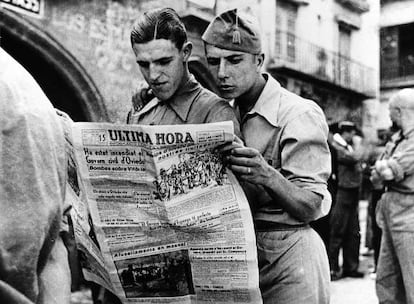The hunter of instants
Centelles captured cruelty and kindness amid Spain's dark past


Agustí Centelles' life changed in 1933 during a soccer match featuring Barça. But it wasn't because his favorite team won. Instead, it was because he spotted a German journalist carrying a Leica camera, the first one he'd ever seen. Unlike the heavy cameras of the era, this one was light, it had an autonomous battery and a flash, and it could take 36 photographs on its flexible film roll. After buying one, he became the best-equipped and fastest photographer in all of Barcelona. Wherever there was something to shoot, Centelles was there with his Leica. The city's newspapers did not go to press until his fresh shots came into the newsroom.
Now, 110 images by this "instant hunter," considered the Spanish equivalent of Robert Capa, are on display at the Vila Casas Foundation in the Catalan capital. It is the first show since Centelles' death in 1985 to be made up of copies that the photographer made personally, after recovering a lost suitcase containing over 5,000 negatives in 1976. Up until now, Centelles shows featured copies made by third parties from negatives bought by the Culture Ministry for 700,000 euros from his sons, Octavi and Sergi. (The 2009 sale caused controversy in Catalonia because the material was taken to a center in Salamanca instead of remaining in the region).
The photographs constitute graphic news stories that are shown in chronological order, from the days of the Spanish Republic to the French concentration camps for Civil War exiles, from 1939 onwards. Centelles covered sports, shows, popular celebrations and public events in which he captured the political leaders of the era, such as Catalan chief Lluís Companys looking ill, covering his mouth with a handkerchief following his release from Santa María penitentiary in Cádiz, where he was jailed from 1934 to 1936.
But it was during the Civil War when he took some of his most iconic shots, such as the image of the assault guards shielding themselves behind dead horses on Diputació street. He captured the harsh effects of the war, especially in Lleida, where he photographed a group of children killed by Italian bombs, and also the kinder moments, like the shot of two soldiers reading a newspaper together or two militia members celebrating their wedding, fists in the air.
Agustí Centelles. Una crónica fotográfica, años 30. Until February 10, 2013 at Museo Can Framis, C/ Roc Boronat 116-126, Barcelona. www.fundaciovilacasas.com
Tu suscripción se está usando en otro dispositivo
¿Quieres añadir otro usuario a tu suscripción?
Si continúas leyendo en este dispositivo, no se podrá leer en el otro.
FlechaTu suscripción se está usando en otro dispositivo y solo puedes acceder a EL PAÍS desde un dispositivo a la vez.
Si quieres compartir tu cuenta, cambia tu suscripción a la modalidad Premium, así podrás añadir otro usuario. Cada uno accederá con su propia cuenta de email, lo que os permitirá personalizar vuestra experiencia en EL PAÍS.
¿Tienes una suscripción de empresa? Accede aquí para contratar más cuentas.
En el caso de no saber quién está usando tu cuenta, te recomendamos cambiar tu contraseña aquí.
Si decides continuar compartiendo tu cuenta, este mensaje se mostrará en tu dispositivo y en el de la otra persona que está usando tu cuenta de forma indefinida, afectando a tu experiencia de lectura. Puedes consultar aquí los términos y condiciones de la suscripción digital.
Últimas noticias
Trump clarifies who is ultimately in charge in Venezuela: ‘Me’
Maduro pleads not guilty before the federal court in New York: ‘I am still the president of Venezuela’
A new test can detect Alzheimer’s from a finger prick
UN team enters Sudanese city of El Fasher after paramilitary massacre: ‘It’s like a ghost town’
Most viewed
- Gilles Lipovetsky: ‘If you want to live better and fall in love, take Prozac, don’t look to philosophy’
- Alain Aspect, Nobel laureate in physics: ‘Einstein was so smart that he would have had to recognize quantum entanglement’
- Alvin Hellerstein, a 92-year-old judge appointed by Bill Clinton, to preside over Maduro’s trial in New York
- Why oil has been at the center of Venezuela-US conflicts for decades
- Cuba confirms death of 32 of its citizens in the US attack against Venezuela








































